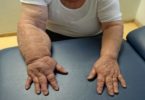Breast self-exam is a way that you can check your breasts for changes such as lumps or thickenings. It includes looking at and feeling your breast. Any unusual changes should be reported to your doctor. When breast cancer is detected in its early stages, your chances of surviving the disease are greatly improved. Beginning in their 20s, women should be told about the benefits and limitations of breast self-exam. Even those who choose
not to do should be aware of how their breasts normally look and feel and report any new breast changes to a health professional as soon as they are found. Finding a breast change does not necessarily mean there is a cancer. Adult women of all ages are encouraged to perform breast self-exams at least once a month.
For pre-menopausal women, most methods suggest that the self-exam be performed at the same stage of the woman’s menstrual cycle, because the normal hormone fluctuations can cause changes in the breasts. The most commonly recommended time is just after the end of menstruation, because the breasts are least likely to be swollen and tender at this time. Women who are postmenopausal or have irregular cycles might do a self-exam once a month regardless of their menstrual cycle.
Five Steps of a Breast Self-Exam
There are five ways to do a self breast-exam
Step 1:
Begin by looking at your breasts in the mirror with your shoulders straight and your arms on your hips.
Here’s what you should look for:
- Breasts that are their usual size, shape, and color
- Breasts that are evenly shaped without visible distortion or swelling
If you see any of the following changes, bring them to your doctor’s attention:
- Dimpling, puckering, or bulging of the skin
- A nipple that has changed position or an inverted nipple (pushed inward instead of sticking out)
- Redness, soreness, rash, or swelling
Step 2:
Now, raise your arms and look for the same changes.
Step 3:
While you’re at the mirror, look for any signs of fluid coming out of one or both nipples (this could be a watery, milky, or yellow fluid or blood).
Step 4:
Next, feel your breasts while lying down, using your right hand to feel your left breast and then your left hand to feel your right breast. Use a firm, smooth touch with the first few finger pads of your hand, keeping the fingers flat and together. Use a circular motion, about the size of a quarter.
Cover the entire breast from top to bottom, side to side – from your collarbone to the top of your abdomen, and from your armpit to your cleavage.
Follow a pattern to be sure that you cover the whole breast. You can begin at the nipple, moving in larger and larger circles until you reach the outer edge of the breast. You can also move your fingers up and down vertically, in rows, as if you were mowing a lawn. This up-and-down approach seems to work best for most women. Be sure to feel all the tissue from the front to the back of your breasts: for the skin and tissue just beneath, use light pressure; use medium pressure for tissue in the middle of your breasts; use firm pressure for the deep tissue in the back. When you’ve reached the deep tissue, you should be able to feel down to your ribcage.
Step 5:
Finally, feel your breasts while you are standing or sitting. Many women find that the easiest way to feel their breasts is when their skin is wet and slippery, so they like to do this step in the shower. Cover your entire breast, using the same hand movements described in step 4.
See your health care provider if you discover any new breast changes. Conditions that should be checked by a doctor include:
- An area that is distinctly different from any other area on either breast
- A lump or thickening in or near the breast or in the underarm that persists through the menstrual cycle
- A change in the size, shape, or contour of the breast
- A mass or lump, which may feel as small as a pea
- A marble-like area under the skin
- A change in the feel or appearance of the skin on the breast or nipple (dimpled, puckered, scaly, or inflamed)
- Bloody or clear fluid discharge from the nipples
- Redness of the skin on the breast or nipple
If you notice any of the following changes in your breasts, notify your doctor as soon as possible. Possible signs and symptoms of breast cancer include:
Changes in the nipple:
- Tenderness
- Change in appearance
- Nipple that is slightly depressed inward (retracted)
- Scaly
- Reddened
- Any discharge
- Rash
Changes in the appearance of the breast:
- A new lump or lumps in the breast (not all lumps are cancerous)
- Unexplained change in the size or shape of the breast
- Dimpling or puckering on the surface skin of the breast
- Unexplained swelling or shrinking of the breast
- Unexplained pain in one spot that will not resolve
- Redness, warmth, or scaly skin on the breast
- A hard lump, knot, or thickening inside the breast or underarm
- Itchy or scaly skin on the breast
A mammogram is an x-ray that allows a qualified specialist to examine the breast tissue for any suspicious areas. The breast is exposed to a small dose of iodizing radiation that produces an image of the breast tissue. Mammograms can often show a breast lump before it can be felt. They also can show tiny clusters of calcium called microcalcifications. Lumps or specks can be caused by cancer, fatty cells, or other conditions like cysts. Further tests are needed to find out if abnormal cells are present.





